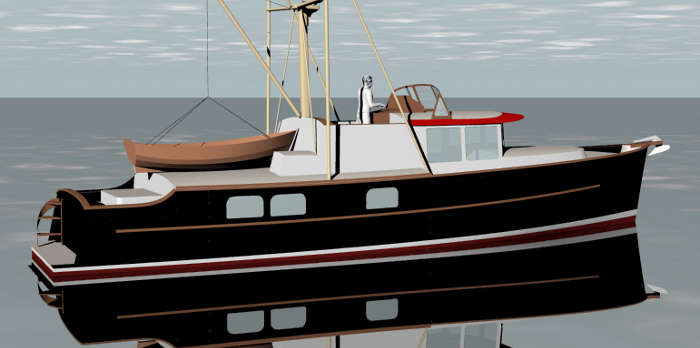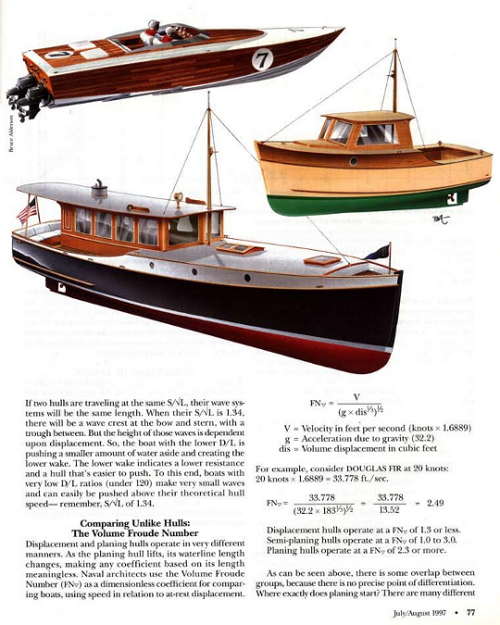Publications
Articles About Sail and Power Boat Design
-
Frequently downloaded articles about sail and power boat design (PDFs):
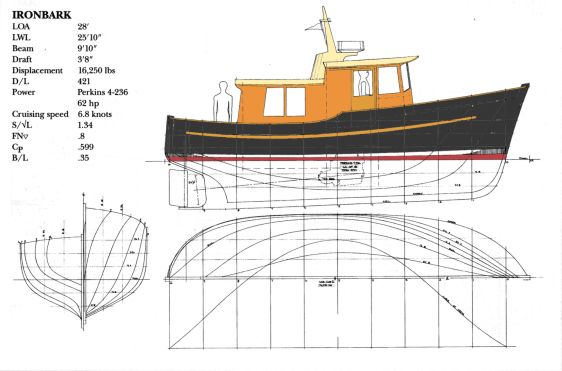 “Power Boat Design: Form and Fuction and Their Effect on Performance” Download the PDF
“Power Boat Design: Form and Fuction and Their Effect on Performance” Download the PDF
“Power Boat Design: Form and Fuction and Their Effect on Performance”
WoodenBoat Number 137, August 1997Analyses the effects of form and function on the performance of 10 power boats, 18ft to 38ft, designed for the article:
38ft. classic motor yacht Yellow Cedar 18ft. flat-bottomed displacement boat Alder 18ft. inshore fisherman Oak 18ft. deep-v Sitka Spruce 28ft traditional displacement boat Ironbark 28ft. displacement boat Douglas FirIronbark carries 2600 lbs of ballast in the form of lead pigs down on top of the keel between the floors. Ballast? in a powerboat, how come? Because it lowers VCG (vertical center of gravity) and lengthens GM. GM is the distance from the CG (center of gravity) to the metacenter. The metacenter's height is dependent on waterplane inertia, a narrow, fine waterplane gives a low metacentric height and a rolly boat. A wide, full waterline gives a tall metacentric height and a stiff boat. As the boat heels the VCB (vertical center of buoyancy) moves about the metacenter, and righting arm is the distance between a vertical line connecting VCB and metacenter, and CG (center of gravity). The longer the GM, the faster a large righting arm is developed, and the faster the boat returns to upright. There is no real agreement on how much GM is enough, Francis S. Kinney in Skene's Elements Of Yacht Design, mentions a GM of 2'-2'6" for small power cruisers. Ironbark is right in the middle of that with a GM of 2.25'. The CG two inches above DWL allows for additions of weight up high, a heavier mast and stabilizer poles, or a dinghy on the cabintop.
Copyright Notice: Verbatim copying and redistribution of the article “Power Boat Design: Form and Fuction and Their Effect on Performance”, copyrighted by Tad Roberts, is permitted provided the origin "www.tadroberts.ca", the author attribute "Tad Roberts", and this notice are preserved.
-
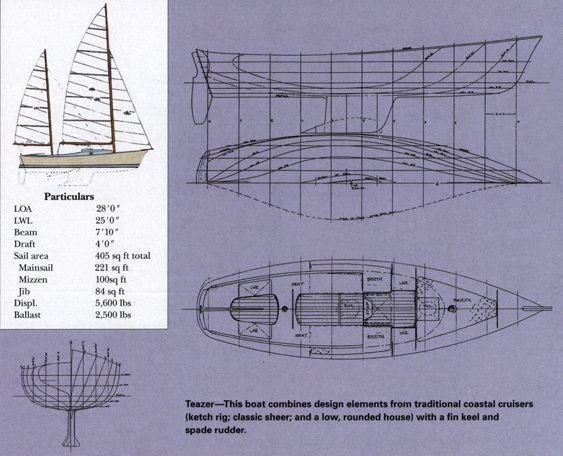 “Sailing Cruiser Design, Part 1: History, Hydrostatics, and Art” Download the PDF
“Sailing Cruiser Design, Part 1: History, Hydrostatics, and Art” Download the PDF
-
“Sailing Cruiser Design, Part 1: History, Hydrostatics, and Art”
Wooden Boat Number 175, November/December 2003Part 1 evaluates the first four of eight cruising sailboats designed for the article: 17ft cat-schooner Capt. Flint 20ft cat-ketch Ratty 28ft coastwise cruising ketch Teazer 29ft 6in. offshore cutter Hero
When looking at the drawing, the first clue to [Teazer's] intended use is the huge cockpit with a short trunk cabin forward. I have taken her strongest elements from traditional cruising designs: classic sheer, the low, rounded house, elliptical transom, and ketch rig. Modern touches are the short overhangs, fin keel and spade rudder, and tight bilge radius with flattish sections amidships. The wild card in this mix is the slight reversal in the stem profile. I think the slight clipper bow balances the short stern nicely and gives Teazer a distinctive look. She is no longer trying to look like a Herreshoff but has developed her own character.
Copyright Notice: Verbatim copying and redistribution of the articles “Sailing Cruiser Design: History, Hydrostatics, and Art, Part 1 and 2”, copyrighted by Tad Roberts, is permitted provided the origin "www.tadroberts.ca", the author attribute "Tad Roberts", and this notice are preserved.
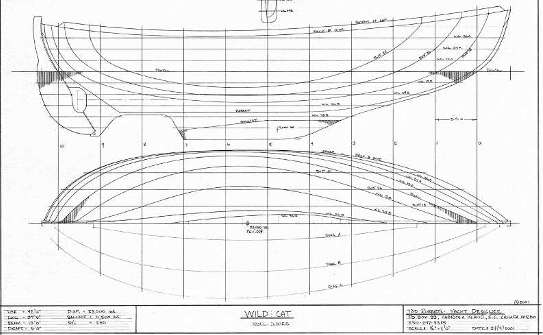 “Sailing Cruiser Design, Part 2: History, Hydrostatics, and Art”Download the PDF
“Sailing Cruiser Design, Part 2: History, Hydrostatics, and Art”Download the PDF
-
“ Sailing Cruiser Design, Part 2: History, Hydrostatics, and Art ”
Wooden Boat Number 176, January/February 2004Part 2 evaluates the last four of eight cruising sailboats designed for the article 32ft centreboard barge Tilikum 34ft 6in. fin-keeled sloop Flash 39ft fin-keeled ocean cruiser Wizard 42ft double-ended schooner Wild Cat
Drawing Wild Cat's lines, with their wonderful symmetry, was a pure pleasure, and it's easy to see how these boats came to captivate people. If I retained Colin Archer's beam/length proportions for Wild Cat, he would come out about 14ft 3in. wide. This would create a nice, roomy interior, but the waterlines would be too full forward, meaning he would be too blunt for good windward performance. Looking at half-angles of entry is an easy way to measure how blunt or fine the bow of a boat is. Measuring the angle between the centreline and waterline at the stem of a Colin Archer rescue vessel gives a result close to 30 degrees. Modern ctruisers run somewhere between 18 degrees and 22 degrees; racers are much finer. Wild Cat came out at 22 degrees.
Copyright Notice: Verbatim copying and redistribution of the articles “Sailing Cruiser Design: History, Hydrostatics, and Art, Part 1 and 2”, copyrighted by Tad Roberts, is permitted provided the origin "www.tadroberts.ca", the author attribute "Tad Roberts", and this notice are preserved.
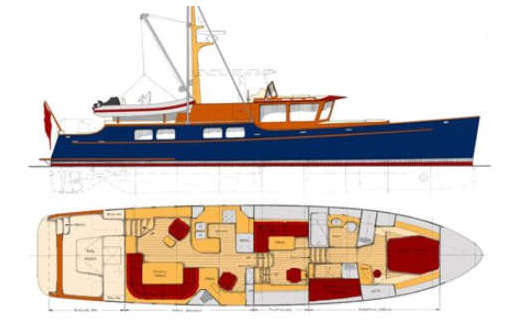 “Passagemaker Lite: A Modern Lightweight Restatement of the Lean Long-range Power Cruiser” Download the PDF
“Passagemaker Lite: A Modern Lightweight Restatement of the Lean Long-range Power Cruiser” Download the PDF
-
“Passagemaker Lite: A Modern Lightweight Restatement of the Lean Long-range Power Cruiser”
Passagemaker Magazine, 2003The article evaluates three Passagemaker Lite designs
Passagemaker Lite 46 Passagemaker Lite 56 Passagemaker Lite 80Passagemaker Lite, the design series presented here, is a high-speed displacement hullform, a shape closer to a naval frigate than a fishing vessel. It has a long waterline, relatively narrow beam, and fine entry. In the manner of a frigate, there is some rise to the sections aft, but there is still deep immersion of the hull at the transom. The prismatic coefficient is fairly high (.678), and displacement is spread out along the hull to counter trimming tendencies. The difference between high-speed displacement and semi-displacement (or semi-planing) is intent: a high-speed displacement hull will slip through the water with minimum resistance, while a semi-displacement form, such as a lobsterboat with its wide flat after-sections, has dynamic lift and stability.
Copyright Notice: Verbatim copying and redistribution of the article “Passagemaker Lite”, copyrighted by Tad Roberts, is permitted provided the origin "www.tadroberts.ca", the author attribute "Tad Roberts", and this notice are preserved.
-
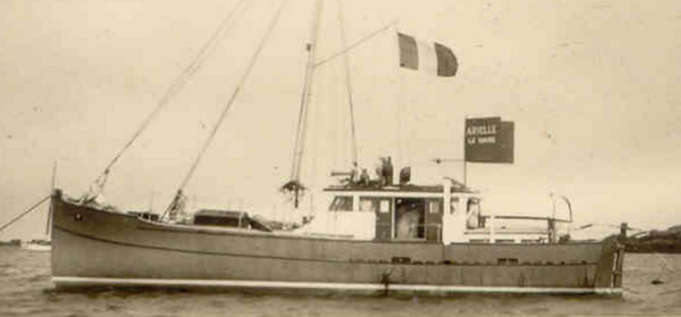 “A Brief History of Lightweight Motor Yachts”
Download the PDF
“A Brief History of Lightweight Motor Yachts”
Download the PDF
“A Brief History of Lightweight Motor Yachts ” Passagemaker2003
Summary: Supporting article that appeared in the same issue with "Passagemaker Lite".
The history of lighter weight, fast boats with serious cruising range goes back almost 100 years. In the early part of the last century, motoryachts such as the 75' x 14' (22.9m x 4.3m) Nokomis, built in 1903, began as refinements of fashionable and elegant sailing yachts. These became the rumrunners and fast commuters of the Roaring Twenties. Engines of the day were of fairly limited power, so efficiency was achieved with long lean hullforms. Marlin, built in 1930 for Edsel Ford to a design by Walter MacInnis, is a fine example of this type. Measuring 51'6" x 12'6" (15.7m x 3.8m) with 3' (1m) draft, the boat was powered by twin 245-hp Sterling gas engines producing a top speed of 24.5 knots at 1,500 rpm. The design was an interesting combination of commuter and sportfisherman. Marlin was capable of 20-knot sprints up Long Island Sound, but most of its cruising would have been at 14 to 15 knots. It is at this speed that the vessel would have headed offshore in search of swordfish.
Copyright Notice: Verbatim copying and redistribution of the article “A Brief History of Lightweight Motor Yachts”, copyrighted by Tad Roberts, is permitted provided the origin "www.tadroberts.ca", the author attribute "Tad Roberts", and this notice are preserved.
